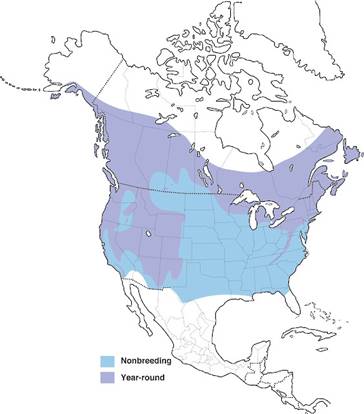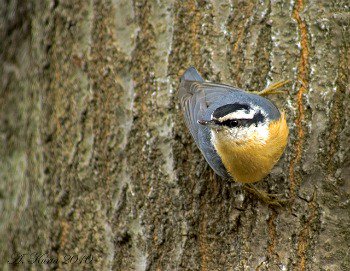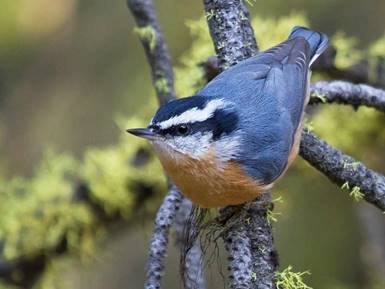I saw him, quite by chance, among
The Crowding leaves. He didn’t lift
His head as he pored over his wood-text.
Ashamed of the binocular intrusion,
Like breath on eggs or love pressed too far,
I’m trying to pretend I never saw him.
–The Nuthatch, Bernard O’Donoghue
This is a small, energetic songbird that can be found throughout the lower 48 states, while its breeding range is more restricted. It is primarily a full-time resident of northern and subalpine conifer forests but regularly “irrupts” southward where the number of winter migrants and the locations vary from year to year. Occasionally wintering birds will reach northern Mexico.

Adults are easily identified – they have a blue-grey back with cinnamon underparts, a white throat and face, with a distinctive black cap and a black stripe running through the eye. Nuthatches are about 4.5 inches long with an 8.5-inch wingspan and tip the scales at a whopping 0.35 ounces. Their call is unmistakable – a quite loud nasal honk, which is quite impressive given the bird’s size. Call
These birds forage on the trunks and large branches of trees, investigating cracks and crevices or briefly flying to catch an insect in flight. Typically, you will spot these birds walking down the trunk of a tree headfirst or upside down beneath a large limb. Unlike woodpeckers or creepers, nuthatches do not use their tail to support themselves while maneuvering on trees. They just seem to stick to the sides of trees with their little bird feet. Their diet changes by season – in the summer they mostly forage on insects, but during the winter they switch over to eating conifer seeds.
They can commonly be found at bird feeders in the winter and will take sunflower seeds, peanut butter, and suet. Nuthatches will often wedge a piece of food into a bark crevice in order to break it apart into more manageable pieces with its beak. The author Peter Matthiessen once wrote in an Audubon Magazine article how he was astonished to see a nuthatch swoop in and pick up a mouse that had just been released from a live-trap by a researcher. That is pretty dang unusual!
Nuthatches are monogamous and the male attracts the female with a display – lifting his head and tail while turning his back to her, dropping his wings, and swaying back and forth. Breeding birds rarely use cavities excavated by other birds and prefer excavating their own nest site. A unique habit of nesting birds is to spread resin around the nest cavity entrance that has been collected from conifer trees, possibly as a deterrent for predators and competitors from entering the nest.

Five to six eggs are laid and incubated by the female, while the male brings her food. The eggs hatch in about 12 days and both parents feed the youngsters, who leave the next in 2-3 weeks.
The genus Sitta, from the Greek sitte, the ancient Geek name for the Eurasian nuthatch; andcanadensis – belonging to Canada. This bird was first described, from Canada, by Mathurin Jacques Brisson in his Ornithologie (1760). Brisson was a French zoologist and natural philosopher. Early in life he concentrated on natural history but also ended up holding the chair of physics at the College of Navarre and was a member of the Academy of Sciences.
These birds are common sights at Seattle bird feeders in the winter and they really enjoy those shelled sunflower seeds. I’ve seen them eat the unshelled seeds by wedging them in cracks on my back deck railing and then splitting them with their beak. Fun with nuthatches
While they can occupy the same tree with other small birds, such as chickadees and bushtits, their feeding strategy and use of the habitat is partitioned from these other birds. The birds’ different niche, or how they forage and function in what first appears as a similar habitat, is a way of carving out a specific feeding strategy and limiting competition for resources. Feeding
These are feisty little birds who enthusiastically investigate intrusions into their territory. I was reading on the back deck recently and heard a nuthatch honking from a couple yards away so I pulled up the iBird Ultimate app on my phone and played a nuthatch call recording. It took less than 30 seconds for the nearby nuthatch to swoop to an adjacent branch and swivel his head around looking for the intruder.
He started calling aggressively which started another bird nearby to start calling (maybe a pair?). This incessant honking lasted for another 10 minutes or so after I turned off the recording until they were both satisfied it was “all clear” and everybody went on with their day.
